Much has already been written on the numerous X-class flares produced by NOAA 2192. In this news item, scientists from the STCE let their light shine on some of the other issues associated to this very active region:
- How does NOAA 2192 compare in size to other sunspot groups?
- How "old" is NOAA 2192?
- How exceptional was NOAA 2192's flaring activity?
- Why were there no obvious CMEs associated to these X-class flares?
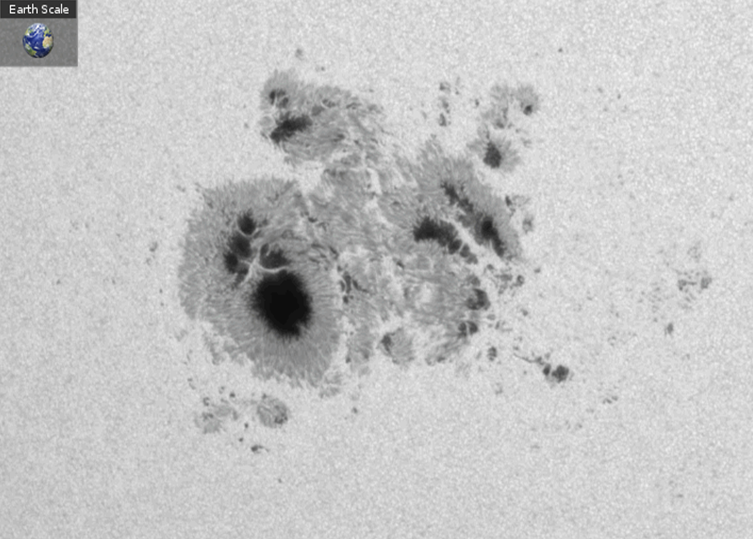
How does NOAA 2192 compare in size to other sunspot groups?
According to the NOAA reports, NOAA 2192 reached a maximum sunspot area of 2750MH (see Note 1) on 26 October. This is comparable to 16 times the Earth's surface area. It is by far the biggest sunspot group of the current solar cycle, and even slightly bigger than the famous Halloween group NOAA 0486 (see Note 2), the largest sunspot region of the previous solar cycle (2610MH). We have to go back already to November 1990 to find the first region which was even bigger (NOAA 6368, 3080MH)!
NOAA 2192 currently ranks 12th in the Top-50 of largest sunspot groups observed since 1874 (see this list for an overview). The largest group appears to have been Greenwich 1488603 which started its transit of the solar disk late March 1947 and reached its maximum sunspot area on 8 April 1947. There are drawings of this sunspot group in the archives of the Kanzelhöhe Observatory. Amazingly, almost the entire NOAA 2192 group would fit in just the main spot of Greenwich 1488603! See image underneath for a comparison.
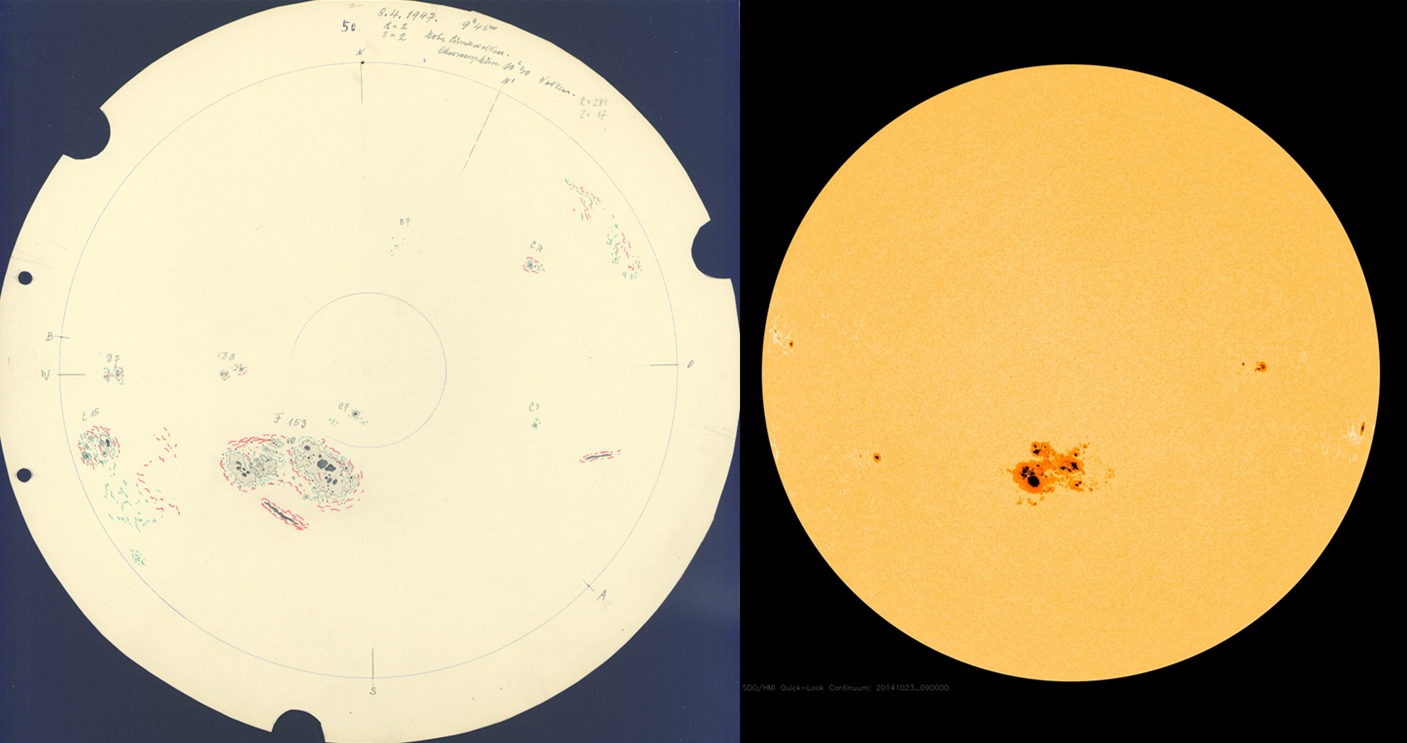
How "old" is NOAA 2192?
It is well known that big sunspot groups can survive for several solar rotations. So, it didn't take long before the blogs were speculating on the number of solar rotations NOAA 2192 had already survived. Some of them were going back till June this year, making NOAA 2192 almost 5 months old!
So, a preliminary analysis was performed of the positions and evolution of the sunspot groups that have appeared in this area starting June this year. As it turns out, most of these groups appeared several degrees to the north or the south of NOAA 2192. More importantly, quite a bit of these groups were decaying. This was for example the case early August when the groups NOAA 2127-2131 were rounding the west limb, and the entire area was nearly devoid of sunspots.
An STCE scientist concludes: "... Indeed, I only see one possible recurrence. There was already a big active region complex (NOAA 2172-2173) at that longitude one month ago, crossing the central meridian on 26 September. However, both active regions were decaying and were about to vanish when passing the west solar limb. Therefore, it may well be that this is the first appearance of NOAA 2192. ..."
He adds: "... Let us keep in mind that the past months marked a high peak in the current cycle, possibly the actual cycle maximum. For an active Sun, there is then always a rather large probability that an active region appears in any longitude "bin" simply because of the high overall density of active regions. ... Therefore, in my sense, all earlier cases before September are obviously due to the random location of emerging active regions."
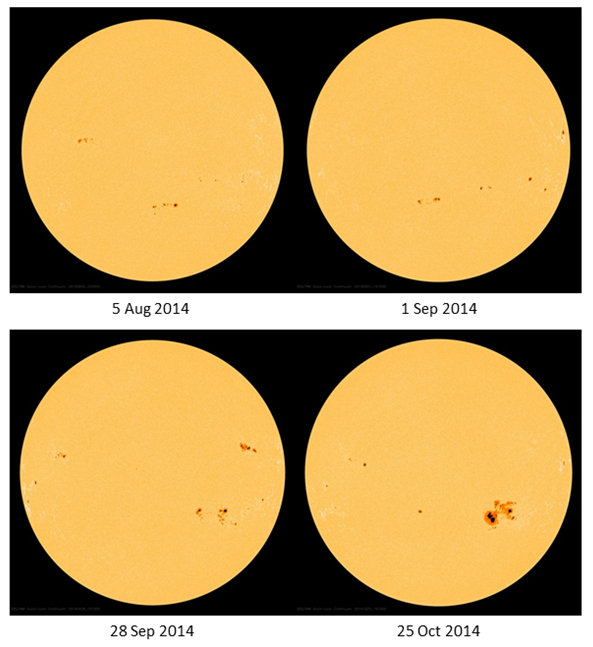
How exceptionnal was NOAA 2192's flaring activity?
NOAA 2192 has produced already 6 X-class flares, and it has not rounded the west solar limb yet. Since systematic solar x-ray observations started in 1976, about 12000 groups have appeared on the solar disk and got a NOAA-number. Yet, only 13 of those sunspot groups managed to produce 6 or more X-class flares during their transit.
The table below shows this "wild bunch". NOAA 5395 (March 1989) and NOAA 0808 (September 2005) are well-known for their high number and particularly intense solar flares. Interesting is that there are a few groups with a relatively small area that also produced 6 X-class flares, such as NOAA 0649 (July 2004). It's also true that big groups not necessarily produce the most or the most intense X-class flares.
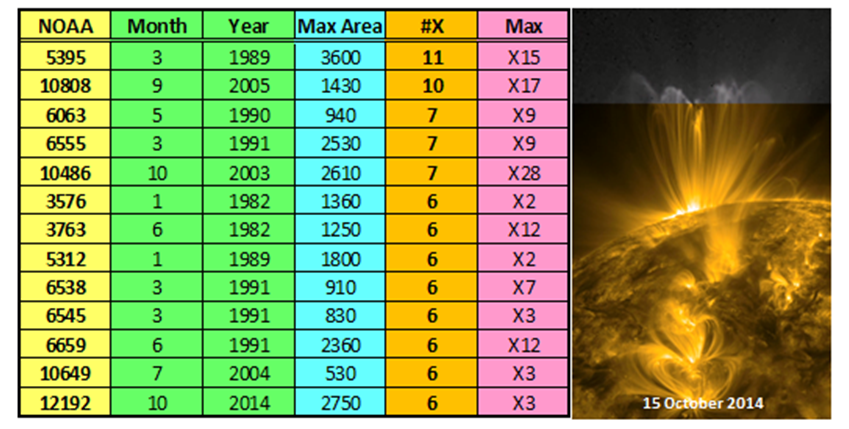
Why were there no obvious CMEs associated to these X-class flares?
THE question of the week was probably why there were no obvious coronal mass ejections (CMEs) associated to all the X-class flares produced by NOAA 2192. Except for the brief HF radio black-outs resulting from the intense x-ray radiation, space weather forcasters were puzzled by the lack of geo-effective effects (no increase in high-energetic particles, no CMEs).
However, scientists of the STCE pointed out that "... Flares and CMEs are both consequences of a restructuring of the magnetic field in the corona. But there are no requirements that both signatures are present. ..." meaning that "... There's nothing in particular that says large flares need to be associated with CMEs. Any large magnetic reconnection event that frees stored ... energy can make a large flare, but the active region is not always in a favorable configuration to produce an eruption. ..."
In the case of NOAA 2192, "... This region appears to be dominated by very strong magnetic fields, which accounts for the strength of the flaring, but does not contain large, unstable prominences. So you can get the interaction of powerful fields and, thus, big flares without freeing a lot of built up field and plasma to erupt. ..." In particular, "... this region's magnetic configuration was close to bipolar on the large scale. So, though it was classified as beta-gamma-delta (see Note 3), the mixed polarities were small and not affecting too much the large-scale magnetic field above the photosphere. ..." In conclusion, statistically, a big flare is usually associated to a CME, but it is certainly not physically required to have both together. In fact, "... confined X-class flares are not that uncommon (for one reason or another). What is uncommon is such a remarkable series of strong flares without a clear CME. ..." Peculiar cases like these perfectly illustrate the fact that there are still significant gaps in our understanding of the generation of CMEs and in predicting space weather in general.
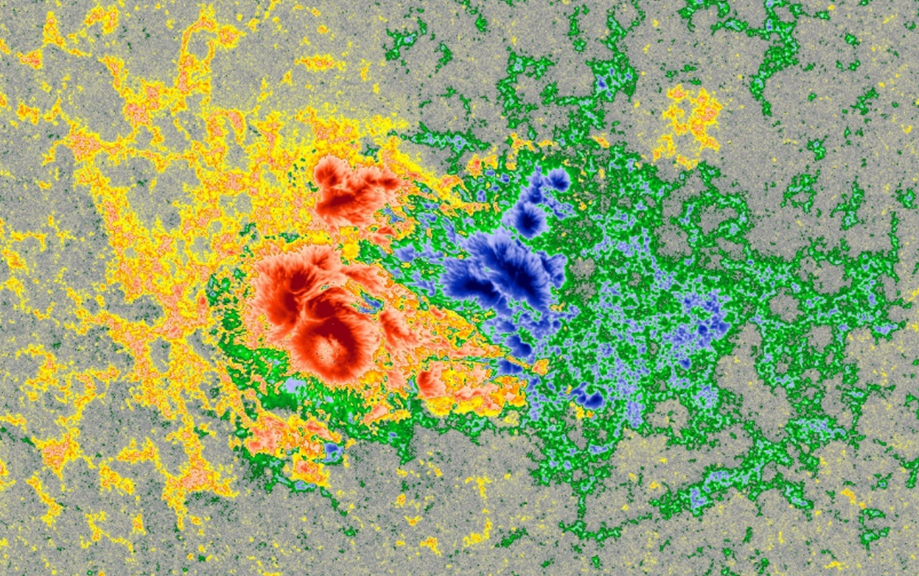
Note 1 - MH: Millionths of a solar hemisphere, with 1MH corresponding to about 3 million km2. The total area of the Earth corresponds to about 167MH, which is a good reference when comparing big sunspot groups.
Note 2 - The NOAA numbering started in 1972, with currently more than 12000 sunspot groups numbered. Starting from group 10000, it is not uncommon to omit the first "1". Hence, in this text e.g. NOAA 0486 is used instead of NOAA 10486.
Note 3 - More on Beta-Gamma-Delta in this news item.
Credits - Data and imagery were taken from SDO, NOAA/SWPC, NASA/MSFC, PROBA2, and Kanzelhöhe Observatory.
 |
 |





